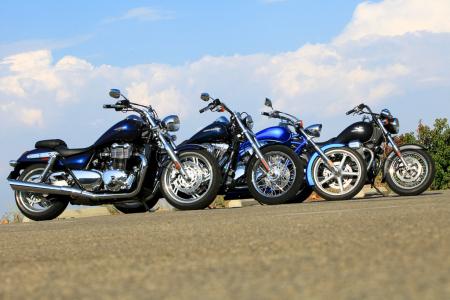2011 World Cruiser Shootout [Video] - Motorcycle.com
If imitation is the sincerest form of flattery, then Harley-Davidson has a lot to blush about. Harley motorcycles unarguably serve as the icon for the form of motorcycle known as a cruiser.
For decades other motorcycle manufacturers have glommed onto the cruiser theme. Some brands unabashedly produce models that look as much like a Harley as possible – Harley clones – without getting into legal hot water, while others just strafe the notion of a cruiser simply by creating a machine with the general look and feel of a cruiser: a neutral if not relaxed riding position and some chrome in just the right amount.
When we contemplated the fact that Harley has inspired so many other brands to interpret the cruiser form, we thought we’d conduct a cruiser comparison review that’s something of an experiment.
Using a Harley-Davidson as the standard, we selected a sampling of brands from around the globe where motorcycle manufacturing has a solid history. We picked models that embody not only the spirit of motorcycles coming out those regions of the world, but also what we think these manufacturers envision as a cruiser.
The World of Cruisers
USA: Harley has basically dictated the paradigm for cruiser motorcycles, and the Super Glide Custom brings the authentic Big Twin H-D experience to consumers for just $13,000.
Italy: An Italian cruiser is unique, whether talking about the wild-ass Diavel or the anachronistic Moto Guzzi Black Eagle tested here. Engines are smaller, chassis are shorter, and seat heights are taller. Italy likes the idea of appealing to the huge American cruiser market but is unwilling to ape the paradigm established by Harley.
UK: Triumph mimics the traditional cruiser layout while throwing a curveball with a parallel-Twin engine configuration unique in the cruiser world. American designer Tim Prentice adopted design cues that make the Thunderbird palatable to North American tastes.
Japan: Like the rest of the motorcycle world, Japan has deeply jumped into the cruiser market, formerly only as pale imitations of Harley's ethos. We originally considered YamaStar's Road Star and Kawi's Vulcan 1700 as likely choices for this shootout, but when those were unavailable, we settled on Honda's Sabre. Honda recognized it needed a firmer connection to the American cruising idiom, so it employed USA-bred designers to create the Fury Chopper and the pro-street-themed Sabre follow-up. Although still not air-cooled and lacking real steel fenders, the Sabre is a clean new riff on the pro-street design that's proven popular in the custom-bike world.
Power Grab
The might of the Thunderbird’s 1597cc parallel-Twin is revealed in its best-in-the-group dyno run of 73.1 hp at 4800 rpm. While the T-Bird’s displacement is scarcely more than the Super Glide Custom’s 1584cc, the Triumph’s engine architecture (including overhead cams and the benefit of liquid cooling) gives it the ability to make considerably more power than the Harley’s air-cooled V-Twin with pushrod actuated valves that managed 64.5 hp at 5000 rpm.
Although the Harley’s TC96 is dominated by the Triumph powerplant, it handily out-grunts the rest of the motors in this group, churning out the grunting flavor that millions have grown to love over the decades. Compared to the Sabre’s 1312cc liquid-cooled, 52-degree V-Twin, well, there is no comparison. The Honda never really feels underpowered, but its power output is simply less than its bigger-cube competition.
With just 1064cc to work with, the California Black Eagle’s quirky, air-cooled, longitudinally mounted V-Twin did well to produce 69.9 hp at 6800 rpm – a scant 3 peak ponies behind the burly T-Bird. But the real story of the Guzzi’s power is that it makes its best power long after the others have hit their stride. The other three cruisers hit peak power long before the California Black Eagle gets into the meat of its powerband.
This rev-happy power in the Guzzi is uncharacteristic for a cruiser and might appeal more to riders with a sporting itch, but the poor ol’ Goose is handily outgunned by the other three in the lower rpm range. Even after the Triumph hits peak power it continues to make more steam than the Guzzi for approximately 1200 rpm. Not until approximately 4600 rpm does the Black Eagle slowly edge away from the liquid-cooled Honda that saw a modest 54 hp at 4200 rpm.
Perhaps more critical to a cruiser rider is twisting force, the amount of grunt a cruiser provides. In this respect, the Italian bird flies low on the torque map, once again showing how different its engine is from the typical cruiser Twin.
Where the typical cruiser builds torque from the word go, the Guzzi suffers a steady decrease in torque starting as early as 2800 rpm, and doesn’t show signs of recovery until nearly 2000 rpm later. Peak torque advantage for the Japanese, American and Brit bikes is measured in the tens of foot-pounds more than the Guzzi’s 59.7 ft-lbs at 5200 rpm.
On paper, the California Black Eagle’s engine looks out of its league, but as we so often say ’round these parts of the web, a motorcycle is more than its dyno results. Let’s see how the Moto Guzzi, as well as the Triumph and Honda, stack up to the cruiser standard-bearing Harley-Davidson.
More by Pete Brissette and Staff
































Comments
Join the conversation